
Illustrative Math Alignment: Grade 6 Unit 1
Arithmetic in Base Ten
Lesson 6: Methods for Multiplying Decimals
Use the following Media4Math resources with this Illustrative Math lesson.
| Thumbnail | Title | Description | Curriculum Nodes |
|---|---|---|---|
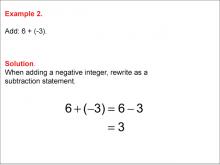
|
Math Example--Arithmetic--Adding Two Integers: Example 2 | Math Example--Arithmetic--Adding Two Integers: Example 2TopicIntegers DescriptionThis example illustrates the addition of a positive and a negative integer: 6 + (-3). When adding a negative integer, it's helpful to rewrite the expression as subtraction. In this case, 6 + (-3) can be rewritten as 6 - 3, which equals 3. This method simplifies the process and helps students understand the relationship between addition and subtraction of integers. |
Numerical Expressions |

|
Math Example--Arithmetic--Adding Two Integers: Example 2 | Math Example--Arithmetic--Adding Two Integers: Example 2TopicIntegers DescriptionThis example illustrates the addition of a positive and a negative integer: 6 + (-3). When adding a negative integer, it's helpful to rewrite the expression as subtraction. In this case, 6 + (-3) can be rewritten as 6 - 3, which equals 3. This method simplifies the process and helps students understand the relationship between addition and subtraction of integers. |
Numerical Expressions |

|
Math Example--Arithmetic--Adding Two Integers: Example 2 | Math Example--Arithmetic--Adding Two Integers: Example 2TopicIntegers DescriptionThis example illustrates the addition of a positive and a negative integer: 6 + (-3). When adding a negative integer, it's helpful to rewrite the expression as subtraction. In this case, 6 + (-3) can be rewritten as 6 - 3, which equals 3. This method simplifies the process and helps students understand the relationship between addition and subtraction of integers. |
Numerical Expressions |

|
Math Example--Arithmetic--Adding Two Integers: Example 3 | Math Example--Arithmetic--Adding Two Integers: Example 3TopicIntegers DescriptionThis example demonstrates the addition of a positive and a negative integer: 5 + (-8). When adding a negative integer, it's beneficial to rewrite the expression as subtraction. In this case, 5 + (-8) can be rewritten as 5 - 8, which equals -3. This method helps students understand that adding a negative number is equivalent to subtracting its positive counterpart. |
Numerical Expressions |

|
Math Example--Arithmetic--Adding Two Integers: Example 3 | Math Example--Arithmetic--Adding Two Integers: Example 3TopicIntegers DescriptionThis example demonstrates the addition of a positive and a negative integer: 5 + (-8). When adding a negative integer, it's beneficial to rewrite the expression as subtraction. In this case, 5 + (-8) can be rewritten as 5 - 8, which equals -3. This method helps students understand that adding a negative number is equivalent to subtracting its positive counterpart. |
Numerical Expressions |

|
Math Example--Arithmetic--Adding Two Integers: Example 3 | Math Example--Arithmetic--Adding Two Integers: Example 3TopicIntegers DescriptionThis example demonstrates the addition of a positive and a negative integer: 5 + (-8). When adding a negative integer, it's beneficial to rewrite the expression as subtraction. In this case, 5 + (-8) can be rewritten as 5 - 8, which equals -3. This method helps students understand that adding a negative number is equivalent to subtracting its positive counterpart. |
Numerical Expressions |

|
Math Example--Arithmetic--Adding Two Integers: Example 3 | Math Example--Arithmetic--Adding Two Integers: Example 3TopicIntegers DescriptionThis example demonstrates the addition of a positive and a negative integer: 5 + (-8). When adding a negative integer, it's beneficial to rewrite the expression as subtraction. In this case, 5 + (-8) can be rewritten as 5 - 8, which equals -3. This method helps students understand that adding a negative number is equivalent to subtracting its positive counterpart. |
Numerical Expressions |

|
Math Example--Arithmetic--Adding Two Integers: Example 3 | Math Example--Arithmetic--Adding Two Integers: Example 3TopicIntegers DescriptionThis example demonstrates the addition of a positive and a negative integer: 5 + (-8). When adding a negative integer, it's beneficial to rewrite the expression as subtraction. In this case, 5 + (-8) can be rewritten as 5 - 8, which equals -3. This method helps students understand that adding a negative number is equivalent to subtracting its positive counterpart. |
Numerical Expressions |

|
Math Example--Arithmetic--Adding Two Integers: Example 3 | Math Example--Arithmetic--Adding Two Integers: Example 3TopicIntegers DescriptionThis example demonstrates the addition of a positive and a negative integer: 5 + (-8). When adding a negative integer, it's beneficial to rewrite the expression as subtraction. In this case, 5 + (-8) can be rewritten as 5 - 8, which equals -3. This method helps students understand that adding a negative number is equivalent to subtracting its positive counterpart. |
Numerical Expressions |

|
Math Example--Arithmetic--Adding Two Integers: Example 3 | Math Example--Arithmetic--Adding Two Integers: Example 3TopicIntegers DescriptionThis example demonstrates the addition of a positive and a negative integer: 5 + (-8). When adding a negative integer, it's beneficial to rewrite the expression as subtraction. In this case, 5 + (-8) can be rewritten as 5 - 8, which equals -3. This method helps students understand that adding a negative number is equivalent to subtracting its positive counterpart. |
Numerical Expressions |

|
Math Example--Arithmetic--Adding Two Integers: Example 3 | Math Example--Arithmetic--Adding Two Integers: Example 3TopicIntegers DescriptionThis example demonstrates the addition of a positive and a negative integer: 5 + (-8). When adding a negative integer, it's beneficial to rewrite the expression as subtraction. In this case, 5 + (-8) can be rewritten as 5 - 8, which equals -3. This method helps students understand that adding a negative number is equivalent to subtracting its positive counterpart. |
Numerical Expressions |

|
Math Example--Arithmetic--Adding Two Integers: Example 3 | Math Example--Arithmetic--Adding Two Integers: Example 3TopicIntegers DescriptionThis example demonstrates the addition of a positive and a negative integer: 5 + (-8). When adding a negative integer, it's beneficial to rewrite the expression as subtraction. In this case, 5 + (-8) can be rewritten as 5 - 8, which equals -3. This method helps students understand that adding a negative number is equivalent to subtracting its positive counterpart. |
Numerical Expressions |

|
Math Example--Arithmetic--Adding Two Integers: Example 3 | Math Example--Arithmetic--Adding Two Integers: Example 3TopicIntegers DescriptionThis example demonstrates the addition of a positive and a negative integer: 5 + (-8). When adding a negative integer, it's beneficial to rewrite the expression as subtraction. In this case, 5 + (-8) can be rewritten as 5 - 8, which equals -3. This method helps students understand that adding a negative number is equivalent to subtracting its positive counterpart. |
Numerical Expressions |

|
Math Example--Arithmetic--Adding Two Integers: Example 4 | Math Example--Arithmetic--Adding Two Integers: Example 4TopicIntegers DescriptionThis example showcases the addition of a positive integer and its negative counterpart: 7 + (-7). When adding a negative integer, it's helpful to rewrite the expression as subtraction. In this case, 7 + (-7) can be rewritten as 7 - 7, which equals 0. This example illustrates an important concept in integer addition: any number added to its opposite results in zero. |
Numerical Expressions |

|
Math Example--Arithmetic--Adding Two Integers: Example 4 | Math Example--Arithmetic--Adding Two Integers: Example 4TopicIntegers DescriptionThis example showcases the addition of a positive integer and its negative counterpart: 7 + (-7). When adding a negative integer, it's helpful to rewrite the expression as subtraction. In this case, 7 + (-7) can be rewritten as 7 - 7, which equals 0. This example illustrates an important concept in integer addition: any number added to its opposite results in zero. |
Numerical Expressions |

|
Math Example--Arithmetic--Adding Two Integers: Example 4 | Math Example--Arithmetic--Adding Two Integers: Example 4TopicIntegers DescriptionThis example showcases the addition of a positive integer and its negative counterpart: 7 + (-7). When adding a negative integer, it's helpful to rewrite the expression as subtraction. In this case, 7 + (-7) can be rewritten as 7 - 7, which equals 0. This example illustrates an important concept in integer addition: any number added to its opposite results in zero. |
Numerical Expressions |

|
Math Example--Arithmetic--Adding Two Integers: Example 4 | Math Example--Arithmetic--Adding Two Integers: Example 4TopicIntegers DescriptionThis example showcases the addition of a positive integer and its negative counterpart: 7 + (-7). When adding a negative integer, it's helpful to rewrite the expression as subtraction. In this case, 7 + (-7) can be rewritten as 7 - 7, which equals 0. This example illustrates an important concept in integer addition: any number added to its opposite results in zero. |
Numerical Expressions |

|
Math Example--Arithmetic--Adding Two Integers: Example 4 | Math Example--Arithmetic--Adding Two Integers: Example 4TopicIntegers DescriptionThis example showcases the addition of a positive integer and its negative counterpart: 7 + (-7). When adding a negative integer, it's helpful to rewrite the expression as subtraction. In this case, 7 + (-7) can be rewritten as 7 - 7, which equals 0. This example illustrates an important concept in integer addition: any number added to its opposite results in zero. |
Numerical Expressions |

|
Math Example--Arithmetic--Adding Two Integers: Example 4 | Math Example--Arithmetic--Adding Two Integers: Example 4TopicIntegers DescriptionThis example showcases the addition of a positive integer and its negative counterpart: 7 + (-7). When adding a negative integer, it's helpful to rewrite the expression as subtraction. In this case, 7 + (-7) can be rewritten as 7 - 7, which equals 0. This example illustrates an important concept in integer addition: any number added to its opposite results in zero. |
Numerical Expressions |

|
Math Example--Arithmetic--Adding Two Integers: Example 4 | Math Example--Arithmetic--Adding Two Integers: Example 4TopicIntegers DescriptionThis example showcases the addition of a positive integer and its negative counterpart: 7 + (-7). When adding a negative integer, it's helpful to rewrite the expression as subtraction. In this case, 7 + (-7) can be rewritten as 7 - 7, which equals 0. This example illustrates an important concept in integer addition: any number added to its opposite results in zero. |
Numerical Expressions |

|
Math Example--Arithmetic--Adding Two Integers: Example 4 | Math Example--Arithmetic--Adding Two Integers: Example 4TopicIntegers DescriptionThis example showcases the addition of a positive integer and its negative counterpart: 7 + (-7). When adding a negative integer, it's helpful to rewrite the expression as subtraction. In this case, 7 + (-7) can be rewritten as 7 - 7, which equals 0. This example illustrates an important concept in integer addition: any number added to its opposite results in zero. |
Numerical Expressions |

|
Math Example--Arithmetic--Adding Two Integers: Example 4 | Math Example--Arithmetic--Adding Two Integers: Example 4TopicIntegers DescriptionThis example showcases the addition of a positive integer and its negative counterpart: 7 + (-7). When adding a negative integer, it's helpful to rewrite the expression as subtraction. In this case, 7 + (-7) can be rewritten as 7 - 7, which equals 0. This example illustrates an important concept in integer addition: any number added to its opposite results in zero. |
Numerical Expressions |

|
Math Example--Arithmetic--Adding Two Integers: Example 4 | Math Example--Arithmetic--Adding Two Integers: Example 4TopicIntegers DescriptionThis example showcases the addition of a positive integer and its negative counterpart: 7 + (-7). When adding a negative integer, it's helpful to rewrite the expression as subtraction. In this case, 7 + (-7) can be rewritten as 7 - 7, which equals 0. This example illustrates an important concept in integer addition: any number added to its opposite results in zero. |
Numerical Expressions |
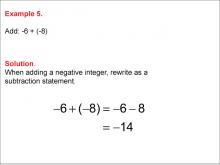
|
Math Example--Arithmetic--Adding Two Integers: Example 5 | Math Example--Arithmetic--Adding Two Integers: Example 5TopicIntegers DescriptionThis example demonstrates the addition of two negative integers: -6 + (-8). When adding negative integers, it's helpful to rewrite the expression as a subtraction statement. In this case, -6 + (-8) can be rewritten as -6 - 8, which equals -14. This method helps students understand that adding two negative numbers results in a number that is more negative than either of the original numbers. |
Numerical Expressions |

|
Math Example--Arithmetic--Adding Two Integers: Example 5 | Math Example--Arithmetic--Adding Two Integers: Example 5TopicIntegers DescriptionThis example demonstrates the addition of two negative integers: -6 + (-8). When adding negative integers, it's helpful to rewrite the expression as a subtraction statement. In this case, -6 + (-8) can be rewritten as -6 - 8, which equals -14. This method helps students understand that adding two negative numbers results in a number that is more negative than either of the original numbers. |
Numerical Expressions |

|
Math Example--Arithmetic--Adding Two Integers: Example 5 | Math Example--Arithmetic--Adding Two Integers: Example 5TopicIntegers DescriptionThis example demonstrates the addition of two negative integers: -6 + (-8). When adding negative integers, it's helpful to rewrite the expression as a subtraction statement. In this case, -6 + (-8) can be rewritten as -6 - 8, which equals -14. This method helps students understand that adding two negative numbers results in a number that is more negative than either of the original numbers. |
Numerical Expressions |

|
Math Example--Arithmetic--Adding Two Integers: Example 5 | Math Example--Arithmetic--Adding Two Integers: Example 5TopicIntegers DescriptionThis example demonstrates the addition of two negative integers: -6 + (-8). When adding negative integers, it's helpful to rewrite the expression as a subtraction statement. In this case, -6 + (-8) can be rewritten as -6 - 8, which equals -14. This method helps students understand that adding two negative numbers results in a number that is more negative than either of the original numbers. |
Numerical Expressions |

|
Math Example--Arithmetic--Adding Two Integers: Example 5 | Math Example--Arithmetic--Adding Two Integers: Example 5TopicIntegers DescriptionThis example demonstrates the addition of two negative integers: -6 + (-8). When adding negative integers, it's helpful to rewrite the expression as a subtraction statement. In this case, -6 + (-8) can be rewritten as -6 - 8, which equals -14. This method helps students understand that adding two negative numbers results in a number that is more negative than either of the original numbers. |
Numerical Expressions |

|
Math Example--Arithmetic--Adding Two Integers: Example 5 | Math Example--Arithmetic--Adding Two Integers: Example 5TopicIntegers DescriptionThis example demonstrates the addition of two negative integers: -6 + (-8). When adding negative integers, it's helpful to rewrite the expression as a subtraction statement. In this case, -6 + (-8) can be rewritten as -6 - 8, which equals -14. This method helps students understand that adding two negative numbers results in a number that is more negative than either of the original numbers. |
Numerical Expressions |

|
Math Example--Arithmetic--Adding Two Integers: Example 5 | Math Example--Arithmetic--Adding Two Integers: Example 5TopicIntegers DescriptionThis example demonstrates the addition of two negative integers: -6 + (-8). When adding negative integers, it's helpful to rewrite the expression as a subtraction statement. In this case, -6 + (-8) can be rewritten as -6 - 8, which equals -14. This method helps students understand that adding two negative numbers results in a number that is more negative than either of the original numbers. |
Numerical Expressions |

|
Math Example--Arithmetic--Adding Two Integers: Example 5 | Math Example--Arithmetic--Adding Two Integers: Example 5TopicIntegers DescriptionThis example demonstrates the addition of two negative integers: -6 + (-8). When adding negative integers, it's helpful to rewrite the expression as a subtraction statement. In this case, -6 + (-8) can be rewritten as -6 - 8, which equals -14. This method helps students understand that adding two negative numbers results in a number that is more negative than either of the original numbers. |
Numerical Expressions |

|
Math Example--Arithmetic--Adding Two Integers: Example 5 | Math Example--Arithmetic--Adding Two Integers: Example 5TopicIntegers DescriptionThis example demonstrates the addition of two negative integers: -6 + (-8). When adding negative integers, it's helpful to rewrite the expression as a subtraction statement. In this case, -6 + (-8) can be rewritten as -6 - 8, which equals -14. This method helps students understand that adding two negative numbers results in a number that is more negative than either of the original numbers. |
Numerical Expressions |

|
Math Example--Arithmetic--Adding Two Integers: Example 5 | Math Example--Arithmetic--Adding Two Integers: Example 5TopicIntegers DescriptionThis example demonstrates the addition of two negative integers: -6 + (-8). When adding negative integers, it's helpful to rewrite the expression as a subtraction statement. In this case, -6 + (-8) can be rewritten as -6 - 8, which equals -14. This method helps students understand that adding two negative numbers results in a number that is more negative than either of the original numbers. |
Numerical Expressions |
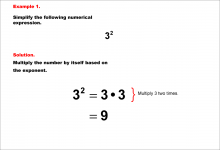
|
Math Example--Exponential Concepts--Integer and Rational Exponents--Example 1 | Math Example--Exponential Concepts--Integer and Rational Exponents--Example 1TopicExponents DescriptionShows Example 1 with the expression 32. The solution explains how to simplify by multiplying 3 by itself according to the exponent. Example 1: Simplify 32. Multiply 3 by itself two times: 3•3 = 9. |
Numerical Expressions |

|
Math Example--Exponential Concepts--Integer and Rational Exponents--Example 1 | Math Example--Exponential Concepts--Integer and Rational Exponents--Example 1TopicExponents DescriptionShows Example 1 with the expression 32. The solution explains how to simplify by multiplying 3 by itself according to the exponent. Example 1: Simplify 32. Multiply 3 by itself two times: 3•3 = 9. |
Numerical Expressions |

|
Math Example--Exponential Concepts--Integer and Rational Exponents--Example 1 | Math Example--Exponential Concepts--Integer and Rational Exponents--Example 1TopicExponents DescriptionShows Example 1 with the expression 32. The solution explains how to simplify by multiplying 3 by itself according to the exponent. Example 1: Simplify 32. Multiply 3 by itself two times: 3•3 = 9. |
Numerical Expressions |
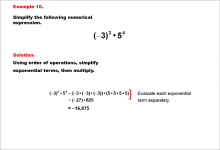
|
Math Example--Exponential Concepts--Integer and Rational Exponents--Example 10 | Math Example--Exponential Concepts--Integer and Rational Exponents--Example 10TopicExponents DescriptionShows Example 10 with the expression (-3)3•54. The solution uses order of operations to evaluate each term before multiplying. Example 10: Simplify (-3)3•54. Evaluate each exponential term separately, then multiply: -27•625= -16,875. |
Numerical Expressions |

|
Math Example--Exponential Concepts--Integer and Rational Exponents--Example 10 | Math Example--Exponential Concepts--Integer and Rational Exponents--Example 10TopicExponents DescriptionShows Example 10 with the expression (-3)3•54. The solution uses order of operations to evaluate each term before multiplying. Example 10: Simplify (-3)3•54. Evaluate each exponential term separately, then multiply: -27•625= -16,875. |
Numerical Expressions |

|
Math Example--Exponential Concepts--Integer and Rational Exponents--Example 10 | Math Example--Exponential Concepts--Integer and Rational Exponents--Example 10TopicExponents DescriptionShows Example 10 with the expression (-3)3•54. The solution uses order of operations to evaluate each term before multiplying. Example 10: Simplify (-3)3•54. Evaluate each exponential term separately, then multiply: -27•625= -16,875. |
Numerical Expressions |
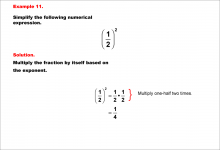
|
Math Example--Exponential Concepts--Integer and Rational Exponents--Example 11 | Math Example--Exponential Concepts--Integer and Rational Exponents--Example 11TopicExponents DescriptionExample 11 shows how to simplify (1/2)2. The image illustrates multiplying 1/2 by itself due to the exponent of 2. Example 11: Simplify (1/2)2. Multiply one-half two times. Solution: (1/2) * (1/2) = 1/4. |
Numerical Expressions |

|
Math Example--Exponential Concepts--Integer and Rational Exponents--Example 11 | Math Example--Exponential Concepts--Integer and Rational Exponents--Example 11TopicExponents DescriptionExample 11 shows how to simplify (1/2)2. The image illustrates multiplying 1/2 by itself due to the exponent of 2. Example 11: Simplify (1/2)2. Multiply one-half two times. Solution: (1/2) * (1/2) = 1/4. |
Numerical Expressions |

|
Math Example--Exponential Concepts--Integer and Rational Exponents--Example 11 | Math Example--Exponential Concepts--Integer and Rational Exponents--Example 11TopicExponents DescriptionExample 11 shows how to simplify (1/2)2. The image illustrates multiplying 1/2 by itself due to the exponent of 2. Example 11: Simplify (1/2)2. Multiply one-half two times. Solution: (1/2) * (1/2) = 1/4. |
Numerical Expressions |
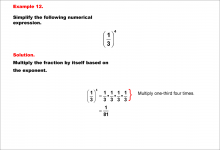
|
Math Example--Exponential Concepts--Integer and Rational Exponents--Example 12 | Math Example--Exponential Concepts--Integer and Rational Exponents--Example 12TopicExponents DescriptionExample 12 shows how to simplify (1/3)4. The image illustrates multiplying 1/3 four times due to the exponent of 4. Example 12: Simplify (1/3)4. Multiply one-third four times. Solution: (1/3) * (1/3) * (1/3) * (1/3) = 1/81. |
Numerical Expressions |

|
Math Example--Exponential Concepts--Integer and Rational Exponents--Example 12 | Math Example--Exponential Concepts--Integer and Rational Exponents--Example 12TopicExponents DescriptionExample 12 shows how to simplify (1/3)4. The image illustrates multiplying 1/3 four times due to the exponent of 4. Example 12: Simplify (1/3)4. Multiply one-third four times. Solution: (1/3) * (1/3) * (1/3) * (1/3) = 1/81. |
Numerical Expressions |

|
Math Example--Exponential Concepts--Integer and Rational Exponents--Example 12 | Math Example--Exponential Concepts--Integer and Rational Exponents--Example 12TopicExponents DescriptionExample 12 shows how to simplify (1/3)4. The image illustrates multiplying 1/3 four times due to the exponent of 4. Example 12: Simplify (1/3)4. Multiply one-third four times. Solution: (1/3) * (1/3) * (1/3) * (1/3) = 1/81. |
Numerical Expressions |
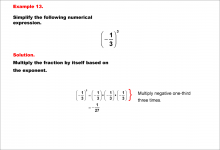
|
Math Example--Exponential Concepts--Integer and Rational Exponents--Example 13 | Math Example--Exponential Concepts--Integer and Rational Exponents--Example 13TopicExponents DescriptionExample 13 shows how to simplify (-1/3)3. The image illustrates multiplying -1/3 three times due to the exponent of 3. Example 13: Simplify (-1/3)3. Multiply negative one-third three times. Solution: (-1/3) * (-1/3) * (-1/3) = -1/27. |
Numerical Expressions |

|
Math Example--Exponential Concepts--Integer and Rational Exponents--Example 13 | Math Example--Exponential Concepts--Integer and Rational Exponents--Example 13TopicExponents DescriptionExample 13 shows how to simplify (-1/3)3. The image illustrates multiplying -1/3 three times due to the exponent of 3. Example 13: Simplify (-1/3)3. Multiply negative one-third three times. Solution: (-1/3) * (-1/3) * (-1/3) = -1/27. |
Numerical Expressions |

|
Math Example--Exponential Concepts--Integer and Rational Exponents--Example 13 | Math Example--Exponential Concepts--Integer and Rational Exponents--Example 13TopicExponents DescriptionExample 13 shows how to simplify (-1/3)3. The image illustrates multiplying -1/3 three times due to the exponent of 3. Example 13: Simplify (-1/3)3. Multiply negative one-third three times. Solution: (-1/3) * (-1/3) * (-1/3) = -1/27. |
Numerical Expressions |

|
Math Example--Exponential Concepts--Integer and Rational Exponents--Example 14 | Math Example--Exponential Concepts--Integer and Rational Exponents--Example 14TopicExponents DescriptionExample 14 shows how to simplify 2-1. The image illustrates rewriting 2-1 as the reciprocal of 2 raised to the first power. Example 14: Simplify 2-1. Negative exponents are written as reciprocals. Solution: 2-1 = 1/2. |
Numerical Expressions |

|
Math Example--Exponential Concepts--Integer and Rational Exponents--Example 14 | Math Example--Exponential Concepts--Integer and Rational Exponents--Example 14TopicExponents DescriptionExample 14 shows how to simplify 2-1. The image illustrates rewriting 2-1 as the reciprocal of 2 raised to the first power. Example 14: Simplify 2-1. Negative exponents are written as reciprocals. Solution: 2-1 = 1/2. |
Numerical Expressions |